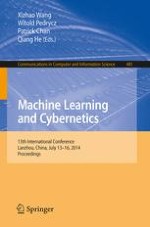This book constitutes the refereed proceedings of the 13th International Conference on Machine Learning and Cybernetics, Lanzhou, China, in July 2014. The 45 revised full papers presented were carefully reviewed and selected from 421 submissions. The papers are organized in topical sections on classification and semi-supervised learning; clustering and kernel; application to recognition; sampling and big data; application to detection; decision tree learning; learning and adaptation; similarity and decision making; learning with uncertainty; improved learning algorithms and applications.
